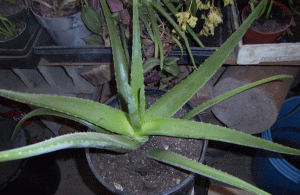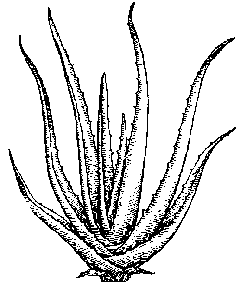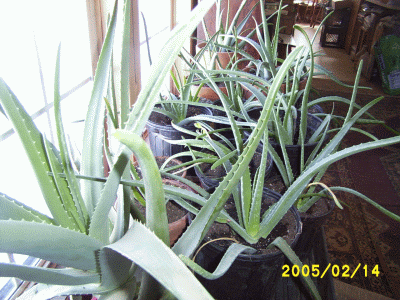


ALOE
. . . a Magical Plant
Aloe—also called Aloe Vera—is an odd plant, looking a little like a cactus. Aloe originated in Africa and was used by the ancient Greeks and Romans as well as in China and India. It grows as a a rosette whose leaves have a leather-like outer cover with spiny edges over a gelatinous interior. This gel is where an aloe stores moisture which enables it to withstand long dry periods. It is this gel that has earned Aloes their reputation as a healing plant.
ALOES AS HOUSEPLANTS
Aloes grow naturally in dry, desert-like areas. They love heat and need little water. These characteristics make it a good choice for a houseplant, since it loves the warm dry air of our winter homes. Although in nature they grow in full sun, aloes do very well in a poorly lit corner which gets little or no sunlight all year.
Note that aloes need only a little water. If you are watering your aloe more than twice a month, you may kill it from over-watering. A good guide is that when you turn the calendar page, give your aloe a drink. An under-watered aloe will have leaves that look thin and shrunken. A well watered aloe will have plump leaves.
Aloes require a minimum continuous temperature of at least 41°F to survive, and are killed by frost. An aloe that has had just its leaf tips frosted may survive is brought inside and the dead leaf tips allowed to dry up so they can be broken off.
Aloes grow slowly, but they do grow! The dark green variety (above, right) grows into a very large plant, and can grow to several feet across and two feet high. The lighter green variegated aloes (above, left) do not get nearly as large, rarely attaining a foot in either height or width. Small plants of either variety can be expected to double in size in a year. The dark green variety above has been recently re-potted. The variegated light green aloe pictured above is a single pot with a mother plant and many daughters that could use replanting.
Aloe grows best in a sweet (slightly alkaline) soil with good drainage. To ensure drainage, don’t add too much organic matter to the potting soil. A sandy loam works well. Most people who their kill aloe plants do so by keeping the soil too wet. Aloe appreciates a little lime added to most Maine soils, but otherwise does well in both fertile and poor soils.
Aloes will thrive for years in the same pot if it has good soil. The plant seems to grow best when the roots are crowded.
If they flower, aloes will send up a slender stalk with obscure flowers on top. More often, an aloe will reproduce by root suckers, resulting in a single mother plant being surrounded by a cluster of daughter plants. If you wish, these clusters can be separated into individual plants and re-potted. Aloes have surprisingly little root system considering the aboveground size of the plant, so replanting is simple. Carefully dump the plants out on your work table and separate the daughter plants from the mother where the daughter’s root connects to the mothers root. This root sprouting process typically happens once a year in winter.
Although aloes natural habitat is outdoors in full sun, suddenly placing an indoor grown aloe in full sun may actually kill it from sunburn! When this happens, the green of the leaves turns a greenish brown, and the plant does not look healthy. Better to slowly acclimate a shade grown aloe to sunlight slowly over several weeks.
ALOE THE HEALER
Aloe’s reputation for healing is well-deserved. Aloes gel has anesthetic, anesthetic and tissue restorative properties. Fresh aloe gel produces the best results. Stabilizers are added to commercial creams and lotions to preserve the efficacy of the gel, but there is good reason to suspect the stabilizers don’t work as advertised. As with so many other herbs and foods, fresh is best.
When applied to burns, scalds or sunburns, the burning sensation of pain disappears almost at once. When applied to cuts or burns, the healing process is tremendously accelerated. When applied to poison ivy, insect bites, or other skin irritations, the itching ceases quickly.
Once you have experienced this yourself, you will forever extol the virtues of aloe.
HOW TO APPLY ALOE
Cut a section of aloe large enough to cover the injury. Since aloe grows from the top, make your cut to one of the older, larger bottom leaves.
Slice the section of aloe leaf starting at one edge cutting almost through to the other edge. Then open the cut leaf and apply to the wound gel side down. This may be held in place with adhesive tape or other bandaging. Change the bandage, applying a new piece of aloe morning and evening. Continue until healing is well underway, usually just a few days. Each time you change the bandage you will notice the gel has disappeared and the wound is getting better.
For small burns and cuts, you can just open a small piece of aloe leaf and rub the gel on the injured area. This method works well for scrapes and sunburns, where the soothing gel quickly removes the discomfort.
If you feel badly about slicing up your favorite houseplant, remember that when you cut an aloe for use on a cut or burn, the aloe itself will also heal quickly. A cut aloe leaf will soon close as the exposed gel dries, pulling the leathery covering together over its wound. Within a week, the cut area on the aloe will be healed completely.
SNAKEROOT ALOE PLANTS
During the warm seasons, we often bring Aloe plants to market. We offer both the variegated type (white spotted, light green leaves) and the solid green type (dark green leaves). The variegated aloe remains a smaller plant and reproduced prolifically, even a small plant will produce a dozen baby aloes each season. The dark green aloe is slower growing, but gets quite large—we have grown them 2 feet across. Dark green aloes tend to reproduce less prolifically than variegated aloes yielding around six baby aloes in midwinter.
The cost of our aloes is from $5.00 to $15.00, depending upon the size and number of plants in the pot.

One of our winter “aloe farms” made by re-potting
a single pot’s aloe family into many pots.
